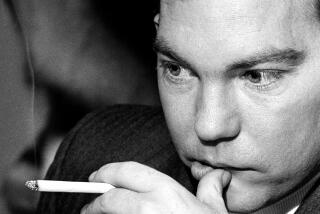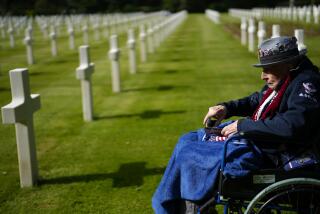Peace Finally Finishes Off the ‘One Nine’
- Share via
CAMP PENDLETON — In an emotional ceremony that opened a rush of both painful and proud memories, the Marine Corps on Friday deactivated the 1st Battalion, 9th Regiment as aging survivors of the famed unit that was known as the “Walking Dead” in Vietnam stood at attention, many with tear-filled eyes.
The hard-luck battalion, which many considered a jinxed unit during the Vietnam War, earned an unenviable reputation for sustaining high casualties and for constantly being engaged in heavy combat.
The “One Nine,” as the unit is commonly called in the Corps, fought in the bloody hill battles in 1967 along the demilitarized zone between North and South Vietnam. It often skirmished along the coastal highway near Hue that soldiers in both the French and U.S. Indochina wars came to know as the Street Without Joy.
And the battalion was also at Khe Sanh in 1968 during an unprecedented, 77-day siege by the North Vietnamese army that many feared would become America’s Dien Bien Phu, the offensive that led to French forces’ withdrawal in 1954.
In addition to Vietnam, the battalion also fought in the island campaigns of World War II, including the assault on Iwo Jima, still the Marine Corps’ most costly battle in terms of dead.
During the One Nine’s four-year stint in Vietnam, from June, 1965, to July, 1969, casualties of 50% or more during engagements were not uncommon.
The unit’s reputation was such that Marine and Navy corpsmen resisted being transferred to what was dubbed the “Purple Heart” battalion, and some wondered whether North Vietnamese soldiers had a special vendetta against it.
“We weren’t jinxed, and there was no vendetta against us. It was just that we were in constant combat,” said Dave (Beetle) Bailey, an Anaheim engineer who served in the One Nine from 1966 to 1967.
Bailey, 50, was wounded for the second time on April 5, 1967, on the Street Without Joy, when a reinforced NVA company overran his understrength company of 60 men, of whom 52 were either killed or wounded.
Friday’s ceremony attracted dozens of former Marines and Navy corpsmen who had served in the battalion and who came from all over Southern California to watch the final folding of the battalion’s colors, emblazoned with Presidential Unit Citations earned in World War II and Vietnam, and carrying the battalion’s distinctive emblem--a large black 9 pierced by a golden bolt of lightning.
Present-day Marines who were assigned to the One Nine were then absorbed into the 2nd Battalion 1st Marine Regiment, which paraded before the Vietnam veterans.
A Marine spokesman said the battalion’s deactivation was made necessary by Pentagon cutbacks dictated by the Cold War’s end.
Dozens of veterans, once inured to the pains of war, had a difficult time holding back tears during the ceremony.
“They were really teen-age soldiers. The mystique of One Nine will grow to life-size proportions over the years,” said Orange County Superior Court Judge David O. Carter, who was wounded three times at Khe Sanh on April 16, 1968. “You had a brief moment in your lifetime to walk beside true heroes. And they are the kids whose names are on the Vietnam (Memorial) wall.”
In all, 620 Marines and Navy corpsmen from the One Nine died in Vietnam. Carter, who was a platoon commander in Company C, said that 38 of “my kids went up the hill” on the day he was wounded, “and only eight came down.”
Although the battalion shed most of its blood in 1967 and 1968, when the North Vietnamese launched aggressive and well-planned campaigns along the so-called demilitarized zone in Quang Tri and Thua Thien provinces, it began to earn its reputation almost as soon as it arrived in Vietnam.
Jose Franco, 49, of Chino was the sole survivor of a five-man fire team that was wiped out on June 10, 1966. Franco’s C Company was sweeping west of Da Nang, near Hill 37, when it was attacked. An enemy mortar round exploded in the midst of his fire team, wounding Franco in the head and killing the others.
“I was unconscious for many days, and then spent a year in the hospital in San Diego. The doctors put a steel plate in my head and I was returned to duty, but not to Vietnam,” said Franco.
During the Vietnam War, the unit’s casualties could occasionally be blamed on the Marines’ tactics as often as they could be attributed to their enemy’s cunning or their own heroism. Critics used to say that the Marine infantry manual consisted of a single page, on which there was but a single printed line: “Hey diddle, diddle, straight up the middle.”
Too often, this was the only tactic used against an enemy that was skillful in outflanking its attackers, in defensive fighting and in picking the most opportune time to engage the Americans.
However, the courage of individual Marines, who often fought under the most trying conditions, was never questioned.
In the early years of the war, most fights were small unit engagements. But all that changed in 1967 in the hill battles along the DMZ, said Al Slater, former commander of A Company.
“The world changed overnight. The NVA came down with bigger guns and more people. We were outnumbered and outgunned. Many Marines died at Con Thien, Dong Ha, Cam Lo, Camp Carroll and the Rock Pile,” said Slater, 53, a juvenile probation officer in San Diego.
The hill battles where One Nine distinguished itself were fierce, often fought in fog and monsoon rain. The fighting was close, hand-to-hand and personal. There was no quarter given by either side, and it was understood that anyone wounded and left behind on the battlefield was not likely to be taken prisoner.
“We came across many Marines who were wounded and then shot in the head by the NVA. There was a lot of bitterness and anger. We hated the NVA, but we also respected them,” said Slater. “There were times when my Marines killed enemy prisoners before I could stop them. You don’t condone things like that, but you understand why it happens.”
Bailey said he has an indelible image of the Walking Dead, symbolized by his own company, which was wiped out the night he was wounded. As the Marines were walking in a line across a field, an illumination round burst overhead.
Instinctively, the men froze in place as the eerie shadows cast by the artificial light rippled across the ground.
“Just for a second I looked to each side of me and saw a line of gray figures, but I couldn’t see their faces. ‘These are the Walking Dead,’ I said to myself,” Bailey recalled.
Moments later, the NVA began firing, catching the Marines in a deadly cross-fire before flanking and overrunning the company.
More to Read
Sign up for Essential California
The most important California stories and recommendations in your inbox every morning.
You may occasionally receive promotional content from the Los Angeles Times.










